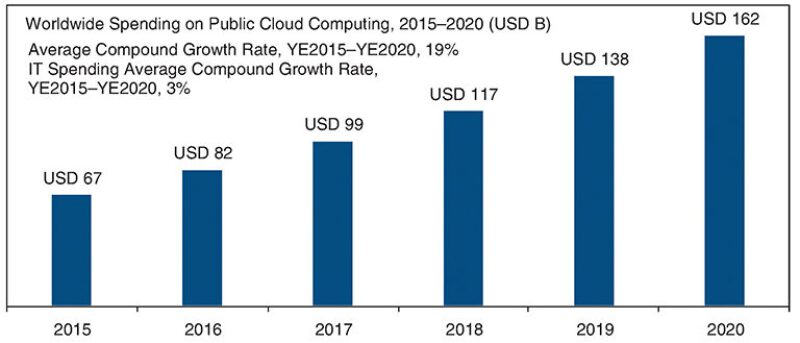The oil and gas business knows that it is on the slow track when it comes to leveraging many of the latest digital technologies. However, this may be a bit of an overstatement when discussing the influence of cloud computing—which allows businesses to crunch data faster than ever before thanks to a nearly unlimited ability to scale up processing power.
Fatima Alsubhi is the chief executive officer of Certis Information Services, a Houston-based information management firm that has helped some of the biggest names in the oil field transition their data and files into the cloud. That experience tells her that cloud platforms are well on their way to becoming the norm in the upstream business, comparable to how advanced oilfield software became mainstream years ago.
“If someone says they increased reliability by 10%, you know part of that is because of the use of software—and now it’s the same thing happening with the cloud,” she explained, adding that the early adopters no longer see cloud services as simply rented server space.
The growing consensus is that cloud platforms combined with software-as-a-service represent a powerful data tool, the limits of which have only begun to be tested. “This is going to evolve and keep moving forward because it just makes sense,” emphasized Alsubhi. “The cloud is cheaper, it’s faster, and it’s easier.”
Plenty of others appear to be in agreement. Take for instance just a few news items from July including an announcement that BP is transferring proprietary information out of its own data centers and into Microsoft’s Azure cloud-based analytics processing platform.
The shift is notable because it represents the latest step in BP’s strategy to shutter its on-premises data centers and fully embrace public cloud platforms. At a recent conference the company said the effort has already cut its IT costs by around 40%.
Also in July, ConocoPhillips made clear its feelings about cloud technology by appointing the founder of a cloud-based analytics company to its board of directors. Around the same time, Amazon Web Services noted in a press release that Halliburton’s Landmark software product line is among the earliest users of its newest cloud product built to support intensive 3D visualizations and virtual reality applications.
These examples all highlight how big oil is warming to the biggest players in cloud technology. But because the cloud market is growing at a far faster rate than traditional IT spend, more small and medium-sized oil and gas producers are expected to begin following suit.

Startups Lowering the Barrier
At least one factor holding back many in the industry—high costs—appears to be eroding thanks to startup companies like Antaeus Technologies.
The Houston-headquartered software-as-a-service firm is going up against tech giants and service companies by charging an annual fee of only USD 500 per user for its cloud database. The next rung up carries an annual fee of USD 3,000 per user which gives users access to custom-developed petrophysics and geomechanical modeling plugins, with more on the way.
These are prices that Pierre Jean Daniel, the chief executive officer of Antaeus, believes operating companies of any size can afford. “Our idea is to democratize more of this cloud technology and make it accessible to everyone,” he said, adding that some of his competition charges a first-year all-in cost of USD 50,000 for the same services.
Moreover, sophisticated oilfield plugins are commonly priced a la carte, and may get more expensive depending on the client company’s market cap.
“We are more like the Netflix model though, where you get all-you-can-eat for a single subscription,” Daniel said, noting that Antaeus is bucking one more conventional pricing practice by not charging early termination fees for its services. “This is the way software is going; you will pay as you go.”
Connecting Dots Above and Below
Petrabytes is another Houston-based startup that is targeting the independent upstream sector with half-a-dozen cloud-based analytics and modeling products. One of the programs aims to make finding sweet spots faster and easier through an artificial-intelligence-driven approach to seismic survey analysis.
“It quickly processes through a lot of seismic images and then identifies a trend, or certain geo-bodies, and also the specific rock types,” explained Sashi Gunturu, the chief executive officer of Petrabytes.
Although this product may be more suited to the mid-sized producer, Petrabytes says such cloud-based tools have attracted pilot projects with two undisclosed majors. The two oil companies have partnered with Petrabytes to expand their capabilities in fiber-optic analysis, specifically distributed acoustic sensing (DAS).
DAS helps shale companies literally hear how their hydraulic fracturing treatments performed. The problem is that the data generated during a single job are measured in terabytes (TB), which makes it impossible for most operators to use DAS in real time. Their alternative is to store the data on a hard drive until someone can look at it and see what happened.
“They literally ship those drives—and for 2 or 3 weeks, there is no analysis,” said Gunturu, who added that the solution he is working on involves the development of an edge device. These small computers can be installed at the wellsite to collect only the most critical pieces of the DAS data.
“You then transmit that knowledge to the cloud” via a network connection or when a field technician returns to an office, explained Gunturu. At the same time, other edge devices may be collecting and sending data to the cloud platform which automatically searches for larger patterns in a company’s well stimulation performance.
Through a new subsidiary, Petrabytes has also developed software for emerging drone technology, which is finding a niche market for quick and cheap site inspections. Some people view drones as flying computers, ones that take measurements with high-definition cameras or even lasers, infrared, and various types of scanning radar.
“The fundamental thing is that you are imaging the data,” with a drone, said Gunturu. This means that drone information can be integrated with other data sets, such as the seismic interpretation of a reservoir.
“I think that will be the holy grail,” he said. “You now have the entire site analyzed—of what’s above and what’s below—and then you can combine that as one unified model. That’s where we are headed.”

No Wi-Fi, No Problem
Another central piece of Antaeus’ big pitch to oil companies is how the easy-to-access nature of the cloud will make business and engineering collaborations more time-efficient. While working for Schlumberger for much of his upstream career, Daniel saw how the simple act of sharing project files via email was leading to big slowdowns.
“Clients were giving me data drop by drop and I couldn’t work,” he said. “Going back and forth like this, we saw how easy it was to lose a week or 2 weeks—especially when you throw different time zones on top of it.”
Daniel also knows firsthand the challenges of working with partners in poorly networked locations where sharing files can be a hit or miss operation. To overcome connectivity issues in remote areas, he said the company has developed a low-bandwidth capability and a portable device that duplicates the most critical aspects of its cloud platform.
“When you go on location, you can synchronize your database onto this box,” which Daniel explained will have around 1 TB of storage and can use mobile networks to provide Wi-Fi for a group of engineers or field techs. “You just put it on the table and everyone inside a truck can work from it.”
Laggards May Not Be Ready
Alsubhi started Certis more than a decade ago and in that time has seen how oil companies have matured in their views on data management. Still though, the trained petroleum engineer turned data specialist knows that many in the business are simply not ready to take full advantage of cloud technology.
“The systems connected within an organization are often very much messy,” she said, explaining that a common result is that important data sometimes get lost.
Without clearly defined lines of where data comes from and where it goes, many companies deal with a bowl of “data spaghetti,” which gets harder to use the more disorganized it becomes. Such poorly structured data workflows may lead to hours of work duplication.
All of this is to say that when a company is ready to make the leap, its first step may not be to call on the cloud service vendors but rather a data management firm that can do the required housekeeping. The pitfall of investing in cloud platforms while importing clumsy workflows or without establishing good data governance is that a company may not see efficiency gains.
Alsubhi gave a real-world example from one of the largest oil companies in the US, name withheld, that involved simplifying its overly complex seismic analysis workflow. “When we mapped it out and put it in front of them, they saw if they just did step No. 12 first, then they didn’t need all the steps in between,” she said.
Her simplest advice to oil and gas companies is to be specific about why they want to improve how they use data and stored files, and not simply view it as something that must be done in order to join the cloud.
“They need to do [information management] with a vision in mind and one that adds real impact to the business itself, not just pockets of unconnected projects,” she said. “So if the goal of a company is to find new prospects or improve its completions, then it needs to do data management projects that help that goal.”
A Cloudy Revolution
The small cloud and data management providers highlighted in this article were all featured at an SPE Gulf Coast Section event held in Houston earlier this summer.
Styled as a faux shark tank, the event allowed each of the firms to pitch their unique business models before a panel of industry experts and observers who delivered candid feedback. No actual investors were involved, and in full disclosure, this writer sat on that panel which was selected by members of the Entrepreneurship Cell, an SPE-sanctioned subcommittee.
Moji Karimi, a co-founder of the Entrepreneurship Cell and the business development manager for the DNA reservoir diagnostics startup Biota, said the firms show that using data to create value is a real and growing industry trend.
The technology areas they specialize in will, according to Karimi, open doors to real-time and automated decision making, increase field efficiency, and improve safety—all while reducing costs. “The industry has no choice but to adapt,” he said, adding that because of this digital revolution “an oil company in 2020 will be radically different than an oil company from 2010.”


